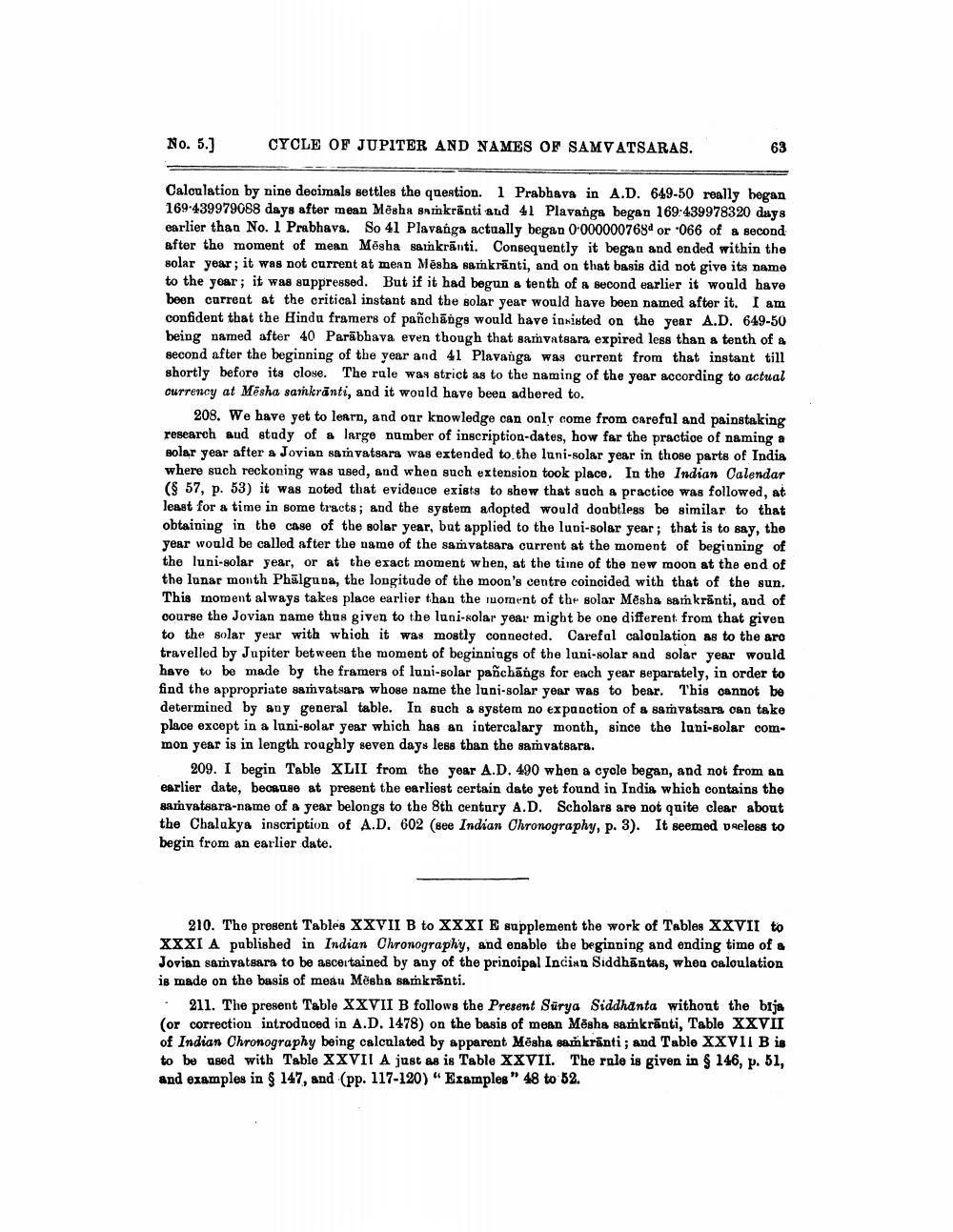________________
No. 5.]
CYCLE OF JUPITER AND NAMES OF SAMVATSARAS.
Calculation by nine decimals settles the question. 1 Prabhava in A.D. 649-50 really began 169-439979088 days after mean Měsha samkrānti and 41 Plavanga began 169:439978320 days earlier than No. 1 Prabhava. So 41 Plavanga actually began 0-0000007684 or 066 of 8 second after the moment of mean Mēsha sainkrānti. Consequently it began and ended within the solar year; it was not current at menn Mēsha samkrānti, and on that basis did not give its name to the year; it was suppressed. But if it had begun a tenth of a second earlier it would have been current at the critical instant and the solar year would have been named after it. I am confident that the Hindu framers of pañchāngs would have insisted on the year A.D. 649-50 being named after 40 Parābhava even though that samvatsara expired less than a tenth of & second after the beginning of the year and 41 Plavanga was current from that instant till shortly before its close. The rule was strict as to the naming of the year according to actual currency at Mesha sankranti, and it would have been adhered to.
208. We have yet to learn, and our knowledge can only come from careful and painstaking research aud study of a large number of inscription-dates, how far the practioe of naming a solar year after a Jovian samvatsara was extended to the luni-solar year in those parts of India where such reckoning was used, and when such extension took place. In the Indian Calendar ($ 57, p. 53) it was noted that evidence exists to shew that such a practice was followed, at least for a time in some tracts; and the system adopted would doubtless be similar to that obtaining in the case of the solar year, but applied to the luni-solar year; that is to say, the year would be called after the name of the samvatsara current at the moment of beginning of the luni-solar year, or at the exact moment when, at the time of the new moon at the end of the lunar month Phālguna, the longitude of the moon's centre coincided with that of the sun. This moment always takes place earlier than the moment of the solar Mesha sam krānti, and of course the Jovian name thus given to the luni-solar year might be one different from that given to the solar year with which it was mostly connected. Carefal caloolation as to the aro travelled by Jupiter between the moment of beginnings of the luni-solar and solar year would have to be made by the framers of luni-solar pañchāngs for each year separately, in order to find the appropriate samvatsara whose name the luni-solar year was to bear. This cannot be determined by any general table. In such a system no expanction of a samvatsara can take place except in a luni-solar year which has an intercalary month, since the luni-solar common year is in length roughly seven days less than the samvatsara.
209. I begin Table XLII from the year A.D. 490 when a cyole began, and not from an earlier date, because at present the earliest certain date yet found in India which contains the samvatsara-name of a year belongs to the 8th centary A.D. Scholars are not quite clear about the Chalukya inscription of A.D. 602 (see Indian Chronography, p. 3). It seemed vreless to begin from an earlier date.
210. The present Tables XXVII B to XXXI E supplement the work of Tables XXVII to XXXI A published in Indian Chronography, and enable the beginning and ending time of a Jovian samvatsara to be ascertained by any of the principal Incinn Siddhāntas, when caloulation is made on the basis of meau Mesha sankranti. . 211. The present Table XXVII B follows the Present Sürya Siddhanta without the bija (or correction introduced in A.D. 1478) on the basis of mean Měsha samkrānti, Table XXVII of Indian Chronography being calculated by apparent Mēsha sankranti; and Tablo XXVII B is to be used with Table XXVII A just as is Table XXVII. The rule is given in $ 146, p. 51, and examples in $ 147, and (pp. 117-120)" Examples" 48 to 52.




